
Theresienstadt Shines a Light on Dark Places in History
By Marni Patterson
When people think of travel, they imagine visiting exotic places they’ve only seen in pictures, hiking mountain trails with views of crystal-clear lakes, and lounging on pristine, white-sand beaches. However, travel can also be a learning experience and expose us to events that aren’t so pleasant, such as the atrocities of the Holocaust.
We had the opportunity to spend a few days in Prague before a Danube River cruise. Since we’re both interested in history, we booked a tour to Theresienstadt, a ghetto euphemistically called the “Country Club” concentration camp.
According to Nazi propaganda, Theresienstadt was a “model Jewish settlement,” but it was really a way station and transit camp for Auschwitz and other extermination camps.
History of Theresienstadt
Emperor Joseph II of Austria built “Terezín” in the late 18th century and named it in honor of his mother, Empress Maria Theresa. The town included small and large fortresses separated by the Ohře River, and its original purpose was to protect Bohemia from Prussian troops during the Austro-Prussian war.
There was no attack during the war. So, Terezín served mainly as a prison for political prisoners. One famous inmate was Gavrilo Princip, the Bosnian Serb who assassinated Archduke Franz Ferdinand and his wife on June 28, 1914.
In 1941 the Nazis established a ghetto in Terezín and renamed it Theresienstadt. They forced residents to relocate and populated the town with Jews from Czechoslovakia, elderly Jews from Germany and occupied countries, and Jews deemed by the Reich to have “special merit,” such as World War I veterans, professors, writers, musicians and artists.
Before the Nazi occupation, the town’s average population was just under 4000 people. During WWII, around 144,000 Jews were interned in Theresienstadt. About 33,000 died from malnutrition and disease, and 88,000 were deported to extermination camps. About 23,000 survived, including 4,000 of the ones who were deported.
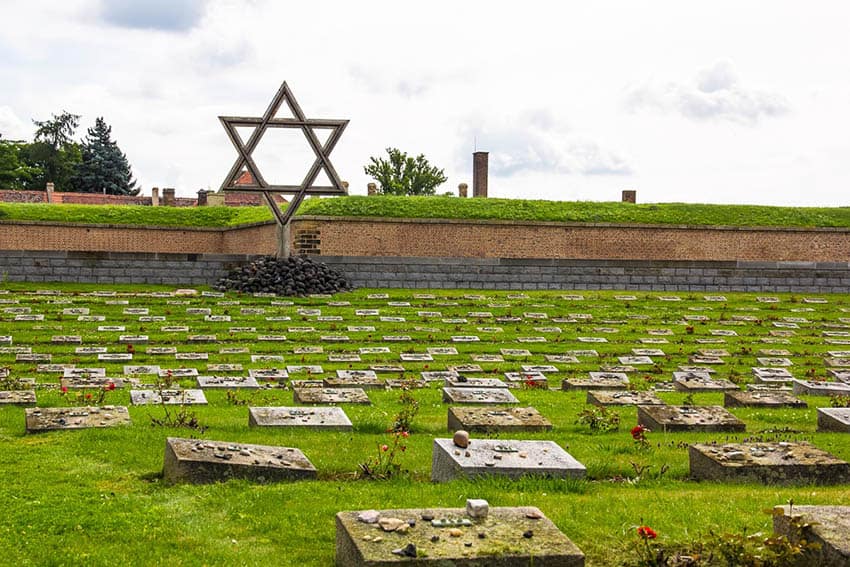
Visiting Theresienstadt
The first part of our tour included the National Cemetery and the Small Fortress (the prison). Then we walked across the river to the Large Fortress, which consists of the town and a military barracks complex. The Small Fortress has been a memorial site since the end of World War II. Other memorials, such as the Magdeburg Barracks and Ghetto Museum, were added later in the Large Fortress.
The National Cemetery
Outside the Small Fortress is the National Cemetery, a final resting place for 10,000 Holocaust victims. Around 2,300 are buried in individual graves, but the others were interred in five mass graves because no one could identify them. A Christian cross with a ring of thorns made from barbed wire and a Star of David made from railroad rails set the somber mood for the rest of the tour.

Entrance to the Small Fortress
At the entrance of the Small Fortress, we were greeted by the “Arbeit Macht Frei” (Work Sets You Free) sign that thousands of deportees saw when they arrived in Theresienstadt. Male prisoners were issued old Czech army uniforms, women kept their civilian clothes, and everyone was required to wear a yellow star. All inmates received a pair of clogs, a blanket, a metal bowl and a spoon.

Living Conditions in Theresienstadt
We visited several courtyards with cells where the prisoners lived. Each contains bunk beds made of wooden planks three tiers high and a single toilet and sink. Our guide said 80 or 90 inmates were in each cell, but we couldn’t see how even half that many could fit.
We also couldn’t see how anyone could have survived long because inmates received 200 grams of bread daily and coffee made of grain twice daily. Those who worked also got soup cooked with rotten vegetables twice a day.
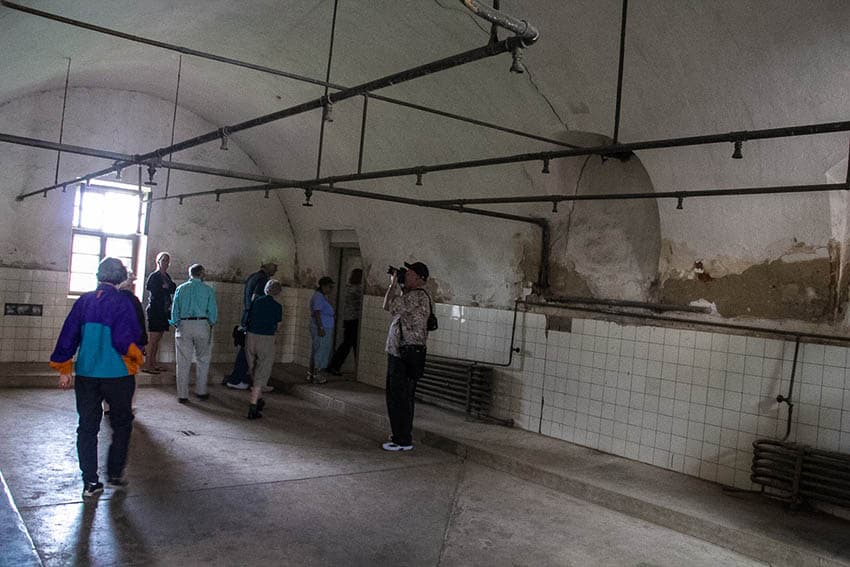
Inmates were occasionally allowed to visit the central shower, which could hold 100 people at a time. The water ran for about 10 minutes while their clothes were steam-treated for lice. Women sometimes had hot water, but men always had cold water. Everyone had to dress in their wet clothes in all types of weather, even if they were going straight to work.
Our last stop was the “punishment cell,” an 8′ x 10′ room for prisoners who participated in the resistance or tried to escape. We learned that there were up to 60 prisoners in this cell at any given time with no toilet, light or fresh air. Only a few people could lie down and sleep. So, everyone else had to stand.
As we left the Small Fortress, a woman in our group said she’d lost relatives in concentration camps. We asked her how it felt to be in a place like Theresienstadt, and she replied, “It feels good to be walking out of here alive.” Good point!
Magdeburg Barracks and Ghetto Museum
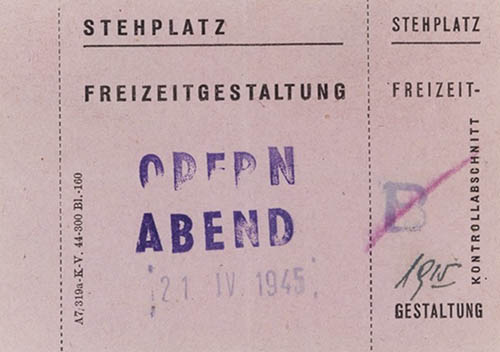
Many prisoners had creative and artistic backgrounds. We next visited the (former) Magdeburg Barracks and the Ghetto Museum in the Large Fortress and saw how education and culture flourished in Theresienstadt despite the terrible conditions.
The Magdeburg Barracks displays drawings and paintings by inmates. Many were created “underground” and smuggled out of the ghetto to show what was happening in Theresienstadt. We also saw items from concerts and theater performances by the prison orchestra and choir.
Most of the exhibits in the Ghetto Museum pay tribute to the thousands of children who lived in Theresienstadt, most of whom didn’t survive. Their drawings and poems are displayed on the wall along with their names and ages.
Keeping Faith Alive
We were inspired to see inmates’ efforts to keep their faith alive. When Asher Berlinger, a religious instructor, was deported to Theresienstadt, he discovered an empty attic space, created a prayer room and held services using liturgical items he’d brought with him.

When František Bubák, the original owner, reclaimed the property after the war, he and his family kept the room a secret to avoid harassment from the Communist government. His descendants notified authorities about the prayer room after the 1989 Velvet Revolution brought democracy to (then) Czechoslovakia. The government restored the space, retaining the original décor, and opened it to visitors in the late 1990s. Today, it’s the only remaining “secret synagogue” in Czechia.
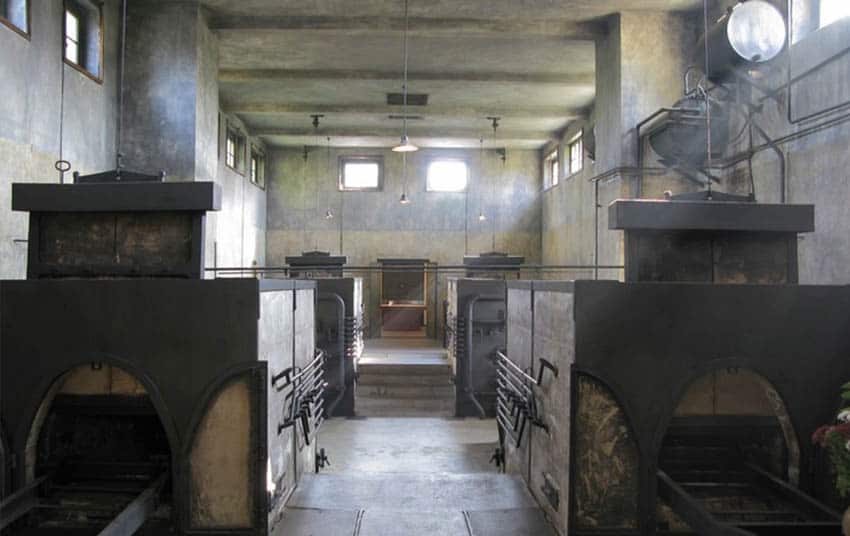
The Crematorium
Since Theresienstadt wasn’t an extermination camp, inmates were buried in individual and mass graves. The Nazis used prisoners to build a crematorium when there was no more space. According to camp records that the Nazis didn’t destroy, around 30 000 bodies were cremated. When allied forces entered the ghetto, they found urns containing victims’ ashes in a columbarium in the fortress ramparts.
Propaganda and the Red Cross Visit
When reports about concentration and extermination camps reached the outside world, the Nazis invited an investigative commission from the International Red Cross to visit Theresienstadt to dispel the “rumors.”
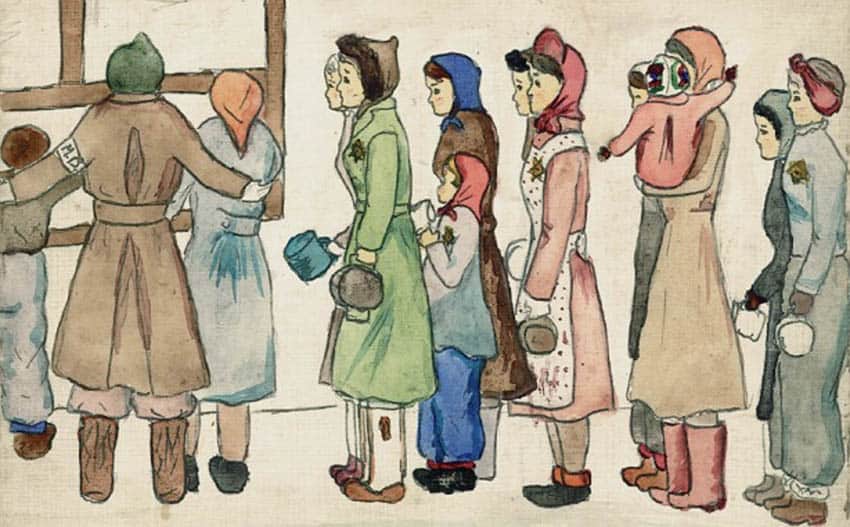
In preparation for the visit, the Nazis deported 7,500 prisoners to reduce overcrowding. They forced the inmates to pave roads, add a playground, construct fake buildings and shops, and plant flower gardens. Prisoners got new clothes and better food and were given strict instructions on what they could and couldn’t say when they talked to the Red Cross delegates.
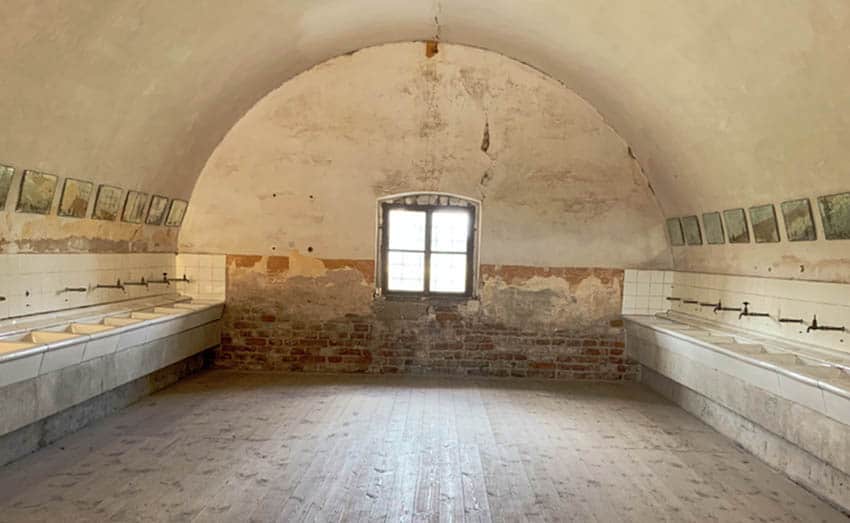
When we entered the “Barber Shop,” one of the rooms that was added to create the façade, our guide said there was a problem in the room and asked us if we could find it. We all surveyed the large room lined with mirrors and sinks but couldn’t see anything wrong. She told us to look under the sinks, and we found there was no plumbing. The room was built for the Red Cross visit but was never used.
When the Red Cross delegation arrived on June 23, 1944, the members saw children playing and people enjoying orchestra and choir performances. They didn’t see that the buildings were fake, and like us, they didn’t spot the problem in the “Barber Shop.” So, they filed a favorable report. To perpetuate the myth, the Nazis released a documentary called The Führer Gives a City to the Jews. After filming, they deported everyone who was in the movie or helped produce it to Auschwitz.

Traveling to Theresienstadt
Terezín is about 40 miles northwest of Prague. If you’re driving, travel north on the D8 highway, take either exit 35 or 45, and Theresienstadt is five minutes away.
Buses from Prague leave from the Nádraží Holešovice Station, Platform #7. At this writing, the fare is 105 CZK (US$4.75). There are two stops in Theresienstadt, one in the Main Square next to the Ghetto Museum and another in front of the Small Fortress. To return to Prague, catch the bus in the Main Square.
Note: There is more than one city named Terezín in Czechia. When checking bus schedules, the final stop should read “Terezín, aut nadr.”
Visiting the Theresienstadt Memorial
You can purchase either a single or combination ticket. Both include a free guided tour that must be booked in advance.
A single ticket includes the Small Fortress or Ghetto Museum, plus the Magdeburg Barracks. It can also be used to see other sites, such as the Prayer Room and the Crematorium.
- Adult: 230CZK (US$10.30)
- Child or Student (6-18 years old) and Senior (65 and older): 200CZK (US$8.95)
A combination ticket includes the Small Fortress, Ghetto Museum and Magdeburg Barracks.
- Adult: 280CZK (US$12.50)
- Child or Student (6-18 years old) and Senior (65 and older): 220CZK (US$9.85)
- Family Ticket (Max 2 adults and 3 children): 540CZK (US$24.25)
There’s no charge for disabled visitors (with disability card), children under 5, teachers and bus drivers with student groups, or former concentration camp prisoners (with proper ID).
Admission is free to everyone on January 27 (International Holocaust Remembrance Day) and the third Sunday in May (Theresienstadt Commemoration Day).
Note: Ticket and pricing information is current as of January 2023. Please check the website for updates.

Why Visit Theresienstadt
You leave a place like Theresienstadt wondering how anyone could have allowed something so horrible to happen. Before we started our tour, the guide said we’d have a late lunch on the way back to Prague because we wouldn’t want to come back. She said we’d understand what she meant when it was time to go.
She was right. Everyone was completely silent as we returned to the van because we were trying to process everything we’d seen. Few people could experience such a grim, dark part of history firsthand and not feel emotionally drained.
German students are required to visit at least one concentration camp while they’re in school to ensure they understand what happened during the Holocaust and why it’s important to see that nothing like this happens again. After visiting Theresienstadt, I think it’d be a good idea if this was required of everyone.
 Marni Patterson is a freelance journalist who writes about destination travel, local customs and cultures, and history. She’s lived all over the U.S., spent a year in Belgium as an exchange student, and now calls Phoenix, Arizona home. You can catch up with her on her website and Instagram.
Marni Patterson is a freelance journalist who writes about destination travel, local customs and cultures, and history. She’s lived all over the U.S., spent a year in Belgium as an exchange student, and now calls Phoenix, Arizona home. You can catch up with her on her website and Instagram.
- Saudi Arabia Might Be Your Next Getaway Spot - April 23, 2024
- Mongolia, the Land of Eternal Blue Sky - April 20, 2024
- These 9 U.S. National Parks Require Reservations in 2024 - April 17, 2024


Thanks so much for this detailed article